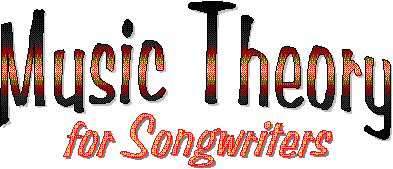



Concept #4 - Getting Started
For your first exploration into the world of songwriting, it's helpful to establish some "rules." These are not rules in the sense that they cannot be broken; these are suggestions or good ideas. You'll do better if you follow these "rules" most of the time.
Rule number 1 - Start and end your song with the I chord. This establishes clearly where you are, and helps both you and the listener experience a strong beginning and ending.
Rule number 2 - I, IV, and V are the three chords you will use most often. Many songs have been written with just these 3 chords.
Rule number 3 - Choose a key. We haven't discussed keys yet, so let's take care of that right here. You already know that a major scale can be numbered 1, 2, 3, 4, 5, 6, 7. Each of these numbers represents a note. You can sing the scale or play it on an instrument.
When you sing, you don't always think of the note as having a name, because your voice can sing high and low and everywhere in between. It may not matter to you what note it is as long as it sounds good. But when you play an instrument like the piano each note has a name and a location on the instrument.
So when you walk up to the piano to play 1, 2, 3, 4, 5, 6, 7 you have to ask a question first. Where is note 1? The answer is you may choose whichever note you like to be note 1. But after you choose note 1, the major scale determines where 2, 3, 4, 5, 6, and 7 are located. You can't just jump around and call them whatever you want. You only get to choose note 1.
Whichever note you choose to be note 1 is the name of the "key." So if you choose a D to be note 1, you will be playing in the key of D. If you choose an A, you will be playing in the key of A. Get it?
This could get confusing, but fortunately we can simplify things a lot with the help of a table.
Take a look at the table and answer this question. In the key of D, can you name the I, IV, and V chords? Sure you can. The I chord is D, the IV chord is G, and the V chord is A.
So what does that mean? It means you can write a simple song in the key of D if you know how to play just three chords: D, G, and A. You will start the song with a D chord because that's the I chord. You will also end the song with a D chord. Along the way you will use D's, G's, and A's whenever you like.
And what do these chords look like? Here they are.
The D chord looks like this.
Here's the G chord.
And here's the A chord.
On a guitar, D, G and A look like this.
Intersection #2
At some point, you will want to learn to play I, IV, and V in other keys, but for now this is enough to illustrate the principle. Our next step is to add in the minor chords; ii, iii, and vi. Just before we head in that direction...
Let's Review
In part two we stated some simple "rules." Start and end your song with the I chord. Along the way use I, IV, and V. Choose a key. If you aren't sure which chords are I, IV, and V, look it up in the table.
We learned that a key has the same name as note 1. So if the key is D major, note 1 must be D.
We looked at the chords D, G, and A, both on a keyboard and on a guitar. We recognized the goal of eventually being able to play I, IV, and V in all twelve of the major keys, but rather than take the time now to explore all of these, we decided to move on to ii, iii, and vi.
Ready for Part Three?
Index - Part 1 - Part 2 - Part 3 - Part 4 - Part 5 - Charts and Maps
Part 6 - Part 7 - Part 8 - Part 9 - 1st Steps in Keyboard - Part 10
Part 11 - Part 12 - 1st Steps in Note Reading
Copyright 2004 Steve Mugglin
Permission is given to make not-for-profit copies
of this material.